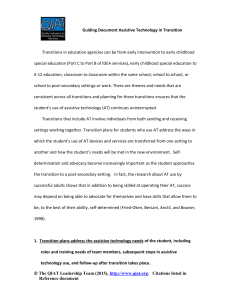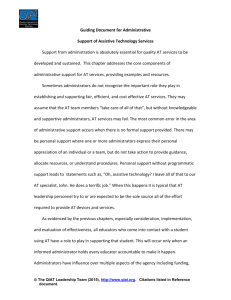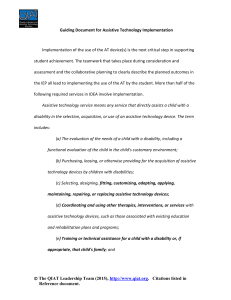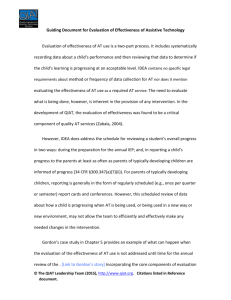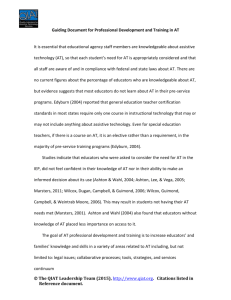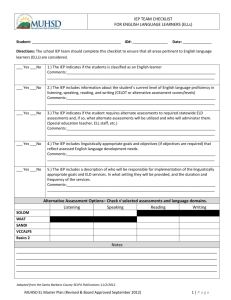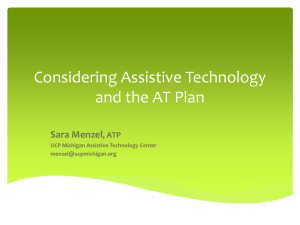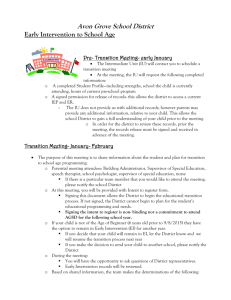GDASSESS-Word
advertisement
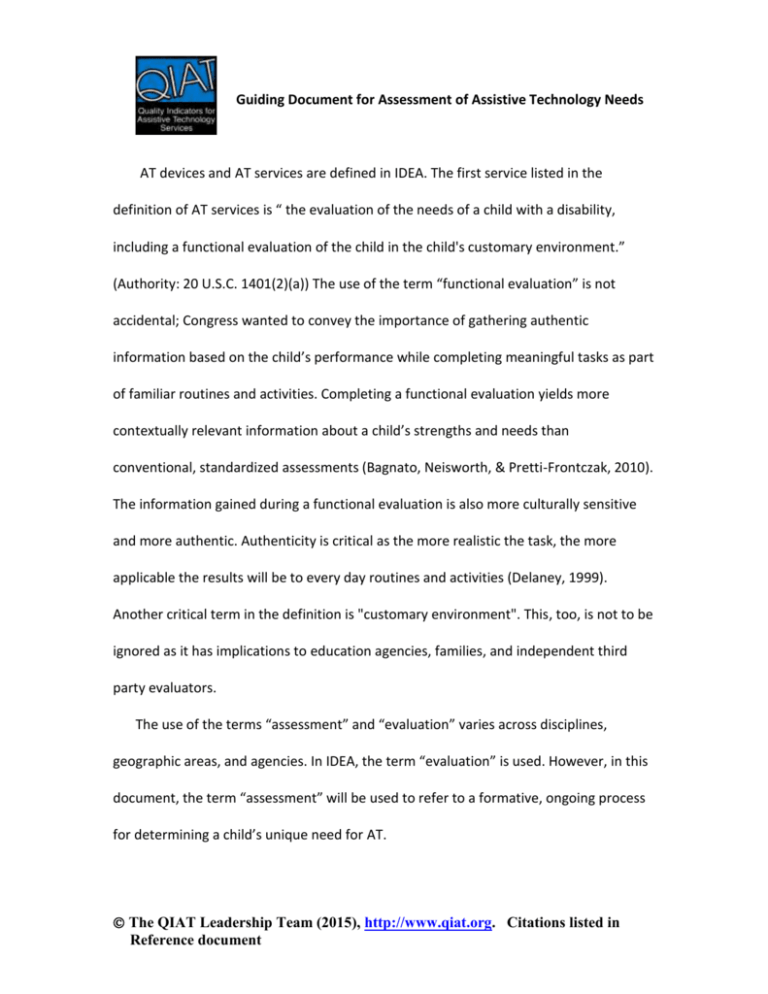
Guiding Document for Assessment of Assistive Technology Needs AT devices and AT services are defined in IDEA. The first service listed in the definition of AT services is “ the evaluation of the needs of a child with a disability, including a functional evaluation of the child in the child's customary environment.” (Authority: 20 U.S.C. 1401(2)(a)) The use of the term “functional evaluation” is not accidental; Congress wanted to convey the importance of gathering authentic information based on the child’s performance while completing meaningful tasks as part of familiar routines and activities. Completing a functional evaluation yields more contextually relevant information about a child’s strengths and needs than conventional, standardized assessments (Bagnato, Neisworth, & Pretti-Frontczak, 2010). The information gained during a functional evaluation is also more culturally sensitive and more authentic. Authenticity is critical as the more realistic the task, the more applicable the results will be to every day routines and activities (Delaney, 1999). Another critical term in the definition is "customary environment". This, too, is not to be ignored as it has implications to education agencies, families, and independent third party evaluators. The use of the terms “assessment” and “evaluation” varies across disciplines, geographic areas, and agencies. In IDEA, the term “evaluation” is used. However, in this document, the term “assessment” will be used to refer to a formative, ongoing process for determining a child’s unique need for AT. The QIAT Leadership Team (2015), http://www.qiat.org. Citations listed in Reference document 1. Procedures for all aspects of assistive technology assessment are clearly defined and consistently applied. Intent: Throughout the education agency, personnel are well informed and trained about assessment procedures and how to initiate them. There is consistency throughout the agency in the conducting of AT assessments. Procedures may include - but are not limited to - initiating an assessment, observing, planning and conducting an assessment, conducting trials, gathering data, reporting results, and resolving conflicts. While AT assessment is not a standardized process, there are steps that are essential and a variety of free and commercial assessment packages (e.g., Wisconsin Assistive Technology Initiative Assessment Packet, 2009; Functional Evaluation of Assistive Technology, 2002; SETT Scaffolds, 1999) that can suggest a scope and sequence of tasks to teams in a variety of settings. Utilizing procedures such as the ones outlined in Table 3.1 and in the Assistive Technology Assessment Planner will guide the process and help ensure useful outcomes. Complete an AT assessment by a collaborative team sharing responsibilities Determine team members Create a written AT assessment plan including: Determine the assessment question(s) Identify expected results & outcomes (e.g. Student will be able to____) Determine what will be measured (e.g. speed, quantity, quality, rate, accuracy, endurance) Assign responsibilities Set a timeline Gather information from multiple sources including previous information (e.g. educational reports, assessments, background interviews and other records) The QIAT Leadership Team (2015), http://www.qiat.org. Citations listed in Reference document Student’s strengths Student’s needs Environmental expectations Tasks (e.g. required curricular work, testing, homework, projects, in-class work, materials, statewide testing & other school functions) Current levels of performance for identified tasks (baseline data) Barriers to participation & independence Analyze information to identify tools & strategies for the trials Determine the features needed Choose tools with appropriate features Determine source of trials from demos, loaners, & rental programs Set timelines Prepare data collection recording method (Measurable determined above) Conduct the trials with identified tools Have student uses tools & strategies in customary environment for identified tasks Collect data Analyze Data Report the results of the trials Revisit the assessment question(s) to determine the outcomes Determine the most appropriate tool(s) & strategies or if additional trials are necessary Document recommendations in written form following district AT procedural guidelines Summarize student performance while using AT tools, including tools that were and were not successful Document appropriate tools and potential impact on student achievement If needed, include specific language for procurement of AT, and possible funding sources Document required tools & strategies in student’s plan (e.g. IEP, 504 Plan) Develop Implementation Plan Instructional/access areas which were explored during the trial Summary of specific skills assessed Written action plan including team member roles & responsibilities Table 3.1 Suggested steps in an AT assessment. Consistency throughout an agency occurs when there are clearly defined procedures and staff is trained on how to implement those procedures. To be effective, procedures for all aspects of the AT assessment process are written and readily available in a manner that is accessible to all in the education agency. Procedures might include: observing the student completing meaningful tasks as part of familiar routines in The QIAT Leadership Team (2015), http://www.qiat.org. Citations listed in Reference document customary environments, reviewing student records, interviewing the student and family, and conducting any formal or informal tests that may be needed to obtain essential information. Individual team members might use informal assessment tools like Every Move Counts (Korsten, Foss & Berry, 2007), the Communication Matrix, (Rowland, 2004), the Protocol for Assessment in Reading (DeCoste, D. & Wilson, L. B. (2012), or the Written Productivity Profile, (DeCoste, D., 2006) to help determine specific student skills. The procedures also describe a decision-making process to ensure collaborative assessment, and all staff members are made aware of the AT assessment process and their role in it. AT assessment procedures are included with all other agency procedures in regular, ongoing updates. The importance of having locally developed, well-defined procedures is discussed more fully in Chapter 8. Example: The South Washington County School District recently hired a new Director of Technology who assumed responsibility for technology with both general education and special education students. As he took over the role, it became evident that there were no defined procedures for AT assessment. While current practice for IEP teams was to ask colleagues for help in determining AT needs, this lacked consistency from team to team and from building to building. After realizing this lack of consistency, an AT task force was developed to create consistent procedures, based on best practices. Some of the tools they used were in the Indicator and Resource sections of the QIAT website (www.qiat.org). The task The QIAT Leadership Team (2015), http://www.qiat.org. Citations listed in Reference document force clearly defined the district’s AT assessment processes: conducting assessments, evaluating related data, identifying device features to support student needs, and conducting trials with the AT in students’ customary environments. Once the procedures for assessment were established, staff was provided internet access to the guidelines as well as training to support their use. After further reflection, the AT task force decided to focus their future work on the area of implementation. Key Questions Where are AT assessment procedures located and how does the staff access them? How is the staff made aware of the procedures, how often are they reviewed, and what is the review process? What aspects of the AT assessment process are addressed in the written procedures? What training do staff members need in order to follow AT assessment procedures? How does the agency ensure that the AT assessment procedures are consistently applied? 2. Assistive technology assessments are conducted by a team with the collective knowledge and skills needed to determine possible assistive technology solutions The QIAT Leadership Team (2015), http://www.qiat.org. Citations listed in Reference document that address the needs and abilities of the student, demands of the customary environments, educational goals, and related activities. Intent: Team membership is flexible and varies according to the knowledge and skills needed to address student needs. The student and family are active team members. Various team members bring different information and strengths to the assessment process. Effective teams that conduct AT assessments include individuals who have knowledge about the student’s strengths and needs, the tasks required of the student and the demands placed on the student in customary settings. The team also includes at least one person who has knowledge about the AT options that might be appropriate. Team members, depending upon individual student needs, may include general and special education teachers, parents, the student when appropriate, therapists such as occupational therapists (OT), physical therapists (PT), speech-language pathologists (SLP), curriculum specialists, technology specialists, and others with unique information to contribute such as a job coach. For example, if communication is an area of deficit, the SLP would be a necessary team member. If the student has a hearing loss, an audiologist or a teacher of students with hearing impairments would be a critical member. The important factor is that no one individual knows or needs to know everything about the student, the environment, the routine tasks, or the potential AT tools, rather each team member contributes important information to create the knowledge base necessary for good decisions. The synergy that occurs as a result of involving the team The QIAT Leadership Team (2015), http://www.qiat.org. Citations listed in Reference document that works with the student on a daily basis is critical. Team members who participate in decision-making and then implement their own decisions are knowledgeable and empowered. They have a vision of what they want to accomplish through the use of AT. Example: Maria is a first grade student in the general education instructional setting. She has developmentally appropriate communication skills; however she uses a wheelchair for mobility and exhibits fine motor difficulties. She has a visual impairment and fatigues easily when asked to complete reading assignments. In addition to her core team of the general education teacher, resource teacher, and family, the team conducting the AT assessment also included an OT, PT, and her teacher of students with visual impairments. It was noted that Maria can understand text when it is read to her, but she is not making adequate progress in reading independently. An AT specialist and reading specialist were requested to help explore specialized formats for print instructional materials. She is also experiencing fine motor difficulty with the production of written output. The team will explore alternative ways for her to complete written assignments. Key Questions What team members are needed to address individual student needs? What knowledge and skills does each team member bring to the process? How is information communicated to all team members? What processes are used to ensure team collaboration? The QIAT Leadership Team (2015), http://www.qiat.org. Citations listed in Reference document 3. All assistive technology assessments include a functional assessment in the student’s customary environments, such as the classroom, lunchroom, playground, home, community setting, or work place. Intent: The assessment process includes activities that occur in the student's current or anticipated environments because characteristics and demands in each may vary. Team members work together to gather specific data and relevant information in identified environments to contribute to assessment decisions. The team begins the assessment process by identifying the student’s unique strengths and needs, the typical environments in which the student participates, and the tasks the student needs to accomplish. Assessment data about the student, the environment and the tasks is gathered and reviewed before AT tools and strategies are suggested. Observation in the classroom and other routine environments will be part of the information gathering and will yield valuable data about critical elements in the environments (e.g., lighting, sound, location of teacher, location of student, type of instructional activity, distractions, typical behavior during routine tasks and activities). Once AT tools that may meet the student’s needs are identified, the student uses them during trial periods established by the team. The extent to which these tools support student success is then evaluated. Data is collected across environments in case the need for AT supports may differ in different settings. While results of assessments conducted outside the customary environments may contain useful information and can contribute to the overall picture, such assessments may not accurately capture information necessary to identify the specific AT tools and The QIAT Leadership Team (2015), http://www.qiat.org. Citations listed in Reference document services needed in the customary home, school and community environments. Such assessments may not include input from IEP team members knowledgeable about the tasks the student needs to accomplish or the characteristics and demands of daily activities and routines in specific customary environments. Example: Jose is a kindergarten student with severe dysarthria and spastic quadriplegia who uses a wheelchair for mobility. His family members are not native English speakers. He participates with his peers in general education settings and attends classes in art, music and physical education. The team collaboratively planned a functional assessment in multiple environments including his home to identify Jose’s skills and abilities and required tasks and demands in each environment. They assigned themselves specific data collection tasks including identifying messages needed for class participation and peer interaction. They will work together to collect data on his communication attempts in various environments and the type of messages he needs to communicate with peers, teachers, and family members. His team will consider the need for AT including communication systems and strategies to meet the identified needs, physical access, mounting, and positioning. They will analyze both the nature and content of his communication attempts and the needs of his communication partners to determine if his communication system will need to be bilingual. The team’s assessment will include analysis of how much his communication needs vary across environments and what the features of an effective communication system will need to be. Trials will be carried out in The QIAT Leadership Team (2015), http://www.qiat.org. Citations listed in Reference document customary environments with one or more stand alone AAC devices, a tablet with AAC apps, or a combination of these before anything is purchased. Key Questions How do teams determine the customary environments in which functional assessments will be completed? How are the tasks identified within each environment to determine which features might be needed to support student achievement? How might AT assessment processes vary across environments? What strategies do team members use to ensure that no critical aspect of the AT assessment is overlooked? 4. Assistive technology assessments, including needed trials, are completed within reasonable timelines. Intent: Assessments are initiated in a timely fashion and completed within a timeline that is reasonable as determined by the IEP team. The timeline complies with applicable state and agency requirements. This Quality Indicator uses the phrase “within reasonable timelines” and the intent statement says “in a timely fashion”. These terms are used because there can be a great deal of variance in what may be considered an acceptable timeline to complete an AT assessment. Part of that variance is due to the fact that based on IDEA, the timeline for an initial evaluation for eligibility for special education can vary in each state. Therefore, The QIAT Leadership Team (2015), http://www.qiat.org. Citations listed in Reference document if the AT assessment is part of the initial evaluation, the time requirement will be whatever has been set by that state. However, the question of AT typically arises after the student has already qualified for special education services as a child with a disability. A new request for assessment of AT (if it has never been provided to the child as part of his or her special education services or never addressed in previous evaluations) may, in some states, trigger a comprehensive reevaluation. The timeline for reevaluation is not specified in the IDEA. In this instance the IEP team determines an appropriate timeline within state or local education agency guidelines or policies. If the student already has AT, but an assessment is needed to identify new or additional AT, it does not generally trigger a comprehensive reevaluation and therefore there may not be any timeline specified by the state or the local education agency. In addition there are other factors that may affect the timeline such as the age of the student, the complexity of needs, and the amount of time needed for trials. It is the responsibility of the IEP team to set a time frame within local and state guidelines that is reasonable to determine what AT the student may need. The length of a trial period is set to provide sufficient opportunity for the student to use the tools and for the impact of the tools on the student’s achievement to be determined. In some cases that may become apparent in a few days, in others a student may require longer to become sufficiently familiar with the device and demonstrate proficiency. Data gathered during the trial period will influence the selection of specific AT. The QIAT Leadership Team (2015), http://www.qiat.org. Citations listed in Reference document Example: Brian has been identified as a student on the autism spectrum. He primarily responds verbally to spoken requests with one to two words. He does respond in writing using a pencil and a small note pad with five to seven words. He rarely initiates verbal interactions with anyone but he occasionally indicates choices through gestures. When he transferred to Harbor Hills School District, his parents provided reports from two previous AT evaluations focused on increasing his expressive output: one completed by his former school district and one conducted by an outside agency that the parents had chosen. The previous school personnel recommended a portable word processor. The outside agency recommended a laptop computer with text-to-speech. However, neither written report included evidence of data from trial use of either AT tool. In the absence of data from trial use, Brian’s team decided to conduct an AT assessment with trial periods of both devices. The team felt these trial periods could support Brian’s expressive language goal. His current IEP did not include any reference to AT. Under state guidelines, the AT assessment would be part of a comprehensive re-evaluation to address his needs. They had 45 school days to complete it within their state’s guidelines. Brian’s team identified current needs related to expressive language in his customary environments and established a timeline that would allow trial use of more than one tool. It was agreed that the portable word processor recommended by his previous school offered potential support for Brian and was selected as the The QIAT Leadership Team (2015), http://www.qiat.org. Citations listed in Reference document first tool for trial use. Data from this first trial period provided information about features he preferred and which resulted in increased length of responses. The team selected a different portable word processor that had the text-to-speech feature that had been recommended by the outside agency and an additional trial period was provided. The data from the two AT device trials was analyzed in order to complete the assessment and make recommendations to the IEP team within the timeline that had been set. They recommended the provision of the portable word processor with text-to-speech. Key Questions What is your state’s specific timeline for initial evaluation and reevaluation? Does your education agency follow the state requirement or does it have a more restrictive policy? How are timelines for trial periods of potential AT solutions determined in your agency? 5. Recommendations from assistive technology assessments are based on data about the student, environments, and tasks. Intent: The assessment includes information about the student's needs and abilities, demands of various environments, educational tasks, and objectives. Data may be gathered from sources such as student performance records, results of The QIAT Leadership Team (2015), http://www.qiat.org. Citations listed in Reference document experimental trials, direct observation, interviews with students or significant others, and anecdotal records. During the assessment process information is collected about the student, the tasks the student needs to be able to do, and the demands of the environments in which the student will do the identified tasks. AT assessment may include both formal and informal testing if that is needed to provide critical information. For example if the team questions the student’s receptive language level, a formal test of receptive language ability may be conducted. If the team finds highly variable data about reading rate when reviewing his portfolio, an informal reading test may be conducted. The assessment activities are selected to yield data about the specific needs and potential effectiveness of AT use. Opportunities to try out the potential AT are a critical part of the AT assessment process. The specific data from any trial periods that are part of the assessment is analyzed to determine whether using the AT was effective in helping the student meet the target outcomes. This analysis helps the team identify key features that are needed on any proposed AT device as well as any additional instruction or services that the student will need. If the analysis does not provide enough information to clearly identify specific AT tools that have potential to help the student with important tasks, additional assessment activities or trials are completed. Following identification of necessary features and analysis of data available from trial periods, recommendations are developed and submitted to the IEP team. The QIAT Leadership Team (2015), http://www.qiat.org. Citations listed in Reference document Example: An AT assessment was initiated because Jamie exhibited behavior outbursts in specific environments. Her team thought that her behavior might be related to an inability to communicate and actively participate in activities. Jamie was using a paper picture-based communication system, but observation and further evaluation showed it was only used as a visual scheduling strategy to show her what was going to happen next (receptive language). Jamie had no independent access to the picture-based system and did not have a way to express herself except through behavior. The team decided to give Jamie her own copy of the picture-based system and encouraged her to use the pictures for expressive communication. Data showed that Jamie understood the expressive use of the pictures almost immediately. She began to use the pictures to communicate her preferred activities, and her behavior outbursts decreased. Jamie experienced so much success with independent access to the picturebased system that the team decided to also try a AAC device. Observation data indicated that the Jamie’s use of expressive language with the AAC device increased and outbursts decreased even more. The key features that Jamie needed were picture based vocabulary, recorded speech, no more than 12 pictures at a time and multiple levels to be used in various activities. The assessment team made a recommendation to the IEP team to consider a device with these features. Key Questions The QIAT Leadership Team (2015), http://www.qiat.org. Citations listed in Reference document How does the team identify expected outcomes of the AT assessment? How is progress toward these outcomes evaluated? What data is used to determine that the student has had ample opportunity to try the AT device(s)? How does the data support the recommendations? 6. The assessment provides the IEP team with clearly documented recommendations that guide decisions about the selection, acquisition, and use of assistive technology devices and services. Intent: A written rationale is provided for any recommendations that are made. Recommendations may include assessment activities and results, suggested AT devices and alternative ways of addressing needs, AT services required by the student and others, and suggested strategies for implementation and use. Recommendations to the IEP team resulting from AT assessment activities need to include information about what was done and what was found. Suggested information to be included is in Table 3.2 Reason for the Assessment A list of the tasks that need to be accomplished by the student in customary environments Current barriers to performance Information regarding AT currently in use and how it is working, if applicable. Process for the Assessment Specific tasks conducted by the assessment team Location where the assessment was conducted Length and conditions under which the assessment was done Accommodations, interventions and strategies, including features of the AT used during the assessment The QIAT Leadership Team (2015), http://www.qiat.org. Citations listed in Reference document Results of the Assessment Changes in the student’s performance when using the AT Specific features of AT tools identified as important Recommended accommodations, interventions and strategies, including any AT devices Table 3.2 Suggested information in an AT assessment report The AT assessment report provides recommendations to the IEP team. The IEP team is empowered by IDEA to make all decisions about the students IEP including decisions about AT. In writing recommendations, it is important to include as much information as possible so the IEP team has clear and complete documentation on which to base their decision. The AT assessment report may include the names of the specific AT devices or tools used during the assessment, but must include a list of critical features that enabled the student to be successful. The inclusion of specific features is important because the IEP team will need that information in writing the IEP document. Example: Jonah is a middle school student who has difficulty generating more than a simple sentence when composing written assignments. The IEP team requested an AT assessment asking for voice recognition technology. The general education teacher provided five writing samples in various genres (narrative, poem, etc.). The AT assessment team observed Jonah in his educational settings. They noted that during class Jonah contributed actively to discussion and group work. His verbal contributions were thoughtful and robust. However, his written work consisted of single sentences with multiple misspellings. Teachers confirmed that this was typical in all settings. The QIAT Leadership Team (2015), http://www.qiat.org. Citations listed in Reference document The assessment team demonstrated the use of voice recognition technology in a quiet room. Jonah immediately asked how he would be able to use this technology in a noisy classroom. The assessment team then showed him word prediction software, which Jonah also liked. Jonah used voice recognition software and word prediction software for three weeks at home and at school. The data showed that Jonah’s written production increased dramatically using each technology. Jonah preferred voice recognition software because it was so fast, but he did not like leaving his classroom in order to use it. He expressed a preference for using word prediction software in school. The IEP team was able to make a well-informed decision because the report described the features Jonah needed. The recommendation from the assessment team to the IEP team was that Jonah would have access to voice recognition at home to complete homework and access to word prediction at school. It listed the important features in each of these options that Jonah would need to be successful. Key Questions How do reports describe the accommodations, interventions and strategies, including AT, that were used during the assessment? What data are included in reports to support recommendations? How do reports explain features of AT that are identified as needed by the student? The QIAT Leadership Team (2015), http://www.qiat.org. Citations listed in Reference document 7. Assistive technology needs are reassessed any time changes in the student, the environments and/or the tasks result in the student’s needs not being met with current devices and/or services. Intent: An AT assessment is available any time it is needed due to changes that have affected the student. The assessment can be requested by the parent or any other member of the IEP team. Over time, the AT a student uses may no longer meet his/her needs effectively because of changes in the student’s skills, environments, tasks, or curricular demands. Additionally, the team may become aware of new technology or updates which have the potential to help the student complete tasks with increased proficiency. A reassessment may also be appropriate when past assessments did not indicate a need for AT, but conditions have changed which would suggest a possible current need. Any IEP team member may request a reassessment to identify new AT that will better address changing student needs. Reassessment may include typical classroom assessments to determine effectiveness of current AT and/or the need for adjustments/modifications/changes. Reassessments may be requested during the annual IEP meeting or at any time when new information is needed. Example: Gus went to camp during the summer after his third grade year. The camp he attended was for kids who had difficulty reading and writing and his parents hoped that the camp would help him overcome his difficulties in school. Before camp, Gus read at the pre-kindergarten level. Due to weak muscles in his hands, he was able to The QIAT Leadership Team (2015), http://www.qiat.org. Citations listed in Reference document write three words per minute with poor legibility when he used a pencil. The school provided a standard word processor for longer writing tasks. While he was at camp, in every activity, there were interesting things to do to help kids improve their literacy skills at the same time they were having fun. For example, when they all built bird houses they read the directions and wrote a paragraph about the birds that would live in it. During camp, Gus showed remarkable progress in reading when he was introduced to a new instructional approach that included word attack skills. To address his difficulty with writing, the camp staff introduced him to software that included word prediction with auditory preview and electronic word banks. At the end of camp, camp staff wrote a report for parents about what they had tried and what they noted about Gus’s performance. During their fall meeting the team reviewed the AT for writing that Gus used at school and his parents shared information about the software he used at camp with the IEP team. The team wondered whether Gus might use AT that is similar to what he used at camp to increase his writing skills. An AT assessment was initiated to help answer this question. Key Questions What changes in student performance have occurred since the previous assessment? What changes in the environment, tasks, or demands on the student have occurred? The QIAT Leadership Team (2015), http://www.qiat.org. Citations listed in Reference document Which student needs are not currently addressed? What does data show about how the current AT supports student performance? What questions will be answered through assessment? The QIAT Leadership Team (2015), http://www.qiat.org. Citations listed in Reference document
